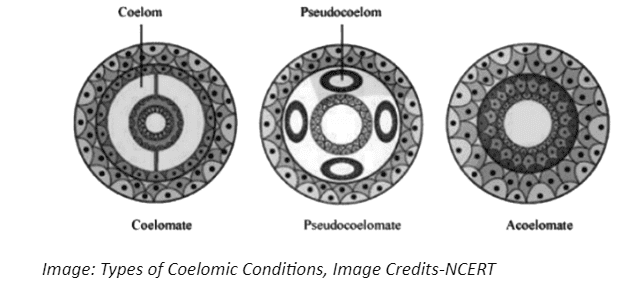Animal Kingdom Class 11 Questions and Answers - Free PDF Download
FAQs on NCERT Solutions For Class 11 Biology Chapter 4 Animal Kingdom - 2025-26
1. What are the major criteria used for the classification of animals in the NCERT Solutions for Class 11 Biology Chapter 4?
The major criteria for classification as explained in the NCERT Solutions for Class 11 Biology Chapter 4 include:
- Levels of organization (cellular, tissue, organ, organ system)
- Symmetry (asymmetrical, radial, bilateral)
- Germ layers (diploblastic, triploblastic)
- Nature of coelom (acoelomate, pseudocoelomate, coelomate)
- Segmentation
- Notochord presence
These features help group animals based on shared structural and functional characteristics.
2. How is the presence or absence of a coelom significant in animal classification as per NCERT Class 11 Biology Chapter 4?
The presence or absence of a coelom (body cavity) is a key classification feature:
- Coelomates have a true, mesoderm-lined cavity (e.g., annelids, arthropods).
- Pseudocoelomates have a cavity not fully lined by mesoderm (e.g., aschelminthes).
- Acoelomates lack a true body cavity (e.g., platyhelminthes).
This determines organ arrangement and complexity in animals.
3. What is the difference between direct and indirect development, as defined in NCERT Solutions for Class 11 Biology Chapter 4 Animal Kingdom?
Direct development occurs without a larval stage—the embryo grows into a mature individual. Indirect development features a larval stage with different characteristics from adults and requires metamorphosis to reach maturity. Direct development is seen in mammals and birds, while indirect development is found in most invertebrates and amphibians.
4. Why are arthropods considered the largest phylum in the Animal Kingdom according to NCERT Solutions?
Arthropods are the largest phylum due to their adaptive features:
- Jointed legs for mobility
- Protective chitinous exoskeleton
- High reproductive capacity
- Ability to occupy diverse environments
These characteristics contribute to their diversity and dominance (over two-thirds of known animal species).
5. How do the NCERT Solutions for Animal Kingdom help clarify the difference between classification and identification?
Classification is the scientific process of grouping organisms based on shared characteristics. Identification involves determining the exact group or species of an unknown organism. Classification provides the framework; identification applies it to individual specimen analysis.
6. What are the unique features of parasitic platyhelminthes as highlighted in Class 11 Biology Chapter 4 NCERT Solutions?
Parasitic platyhelminthes exhibit:
- Dorsoventrally flattened bodies
- Hooks and suckers for attachment
- Thick tegument to resist digestive juices of the host
- Absorption of nutrients via the body surface
- Usually hermaphroditic
Examples include Taenia solium and Fasciola hepatica.
7. What key adaptations enable birds to fly, based on NCERT Solutions for Class 11 Biology Chapter 4?
Important adaptations allowing flight in birds include:
- Streamlined body
- Wings derived from forelimbs
- Feathers for insulation and lift
- Pneumatic (hollow) bones for reduced weight
- Additional air sacs to improve respiration
8. Explain the functional significance of the water vascular system in echinoderms as per NCERT solutions.
The water vascular system in echinoderms (e.g., starfish) is a network of fluid-filled canals and tube feet. It enables locomotion, food capture, and respiration, making it an essential distinguishing feature of the group.
9. What are the six basic classifications of Animal Kingdom outlined in NCERT Solutions for Class 11 Biology Chapter 4?
The main classification criteria include:
- Levels of organization
- Body symmetry
- Number of germ layers
- Coelom (body cavity) type
- Segmentation
- Presence/absence of notochord
10. In what type of organisms is segmentation first seen, according to Class 11 Biology Animal Kingdom?
Segmentation (body division into segments) first appears in phylum Annelida (e.g., earthworm). This feature is important for improved locomotion and specialization of body regions.
11. What is the importance of studying the Animal Kingdom chapter using NCERT Solutions for Class 11?
Using NCERT Solutions for this chapter:
- Builds a conceptual foundation for higher studies
- Clarifies classification criteria and examples
- Prepares students for CBSE/NEET-style questions
- Helps in understanding evolutionary relationships among animals
12. Can the number of eggs laid by oviparous and viviparous animals ever be the same, as per NCERT Solutions for Class 11 Animal Kingdom?
No, usually oviparous animals produce a larger number of eggs compared to the fewer offspring of viviparous animals. This is because eggs developing outside the mother's body are more exposed to environmental hazards and predators, so more eggs are laid to ensure survival of some offspring.
13. What are the steps involved in classifying an animal specimen as per the NCERT Solutions for Class 11 Biology Chapter 4?
The steps for classifying a specimen include:
- Examining basic features (body symmetry, germ layers, coelom presence, segmentation)
- Identifying organ systems and level of organization
- Comparing features with known phyla
- Assigning the specimen to its respective group
14. How does the concept of ‘all vertebrates are chordates but not all chordates are vertebrates’ apply in the context of Animal Kingdom Class 11 NCERT Solutions?
All vertebrates possess the characteristics of chordates (like notochord and gill slits), but not every chordate develops a vertebral column. Thus, vertebrates are a subgroup within chordates, as detailed in the NCERT Solutions.
15. What fundamental misconceptions about animal classification does Class 11 NCERT Solutions help clarify?
NCERT Solutions address misconceptions such as:
- Thinking all animals with similar external features are closely related (convergent evolution can mislead)
- Confusing levels of organization and body plan (e.g., bilateral symmetry does not always mean higher complexity)
- Misunderstanding terms like ‘segmentation’ and ‘coelom’
The solutions provide correct definitions and real examples to clear these doubts.



























